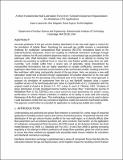| dc.contributor.author | Lubchenko, Nazar | |
| dc.contributor.author | Magolan, Ben | |
| dc.contributor.author | Sugrue, Rosie | |
| dc.contributor.author | Baglietto, Emilio | |
| dc.date.accessioned | 2021-10-27T20:29:14Z | |
| dc.date.available | 2021-10-27T20:29:14Z | |
| dc.date.issued | 2018 | |
| dc.identifier.uri | https://hdl.handle.net/1721.1/135774 | |
| dc.description.abstract | © 2017 Elsevier Ltd Accurate prediction of the gas volume fraction distribution in the near-wall region is critical for the simulation of bubbly flows. Resolving the near-wall gas profile remains a considerable challenge for multiphase computational fluid dynamics (M-CFD) simulations based on the Eulerian–Eulerian framework, where the coupling of interfacial momentum exchange through closure relations for lift and turbulent dispersion leads to a non-physical gas accumulation in the wall-layer cells. Wall lubrication models have been developed in an attempt to remedy this behavior by providing an artificial force to move the void fraction profile away from the wall. Currently, such models suffer from a severe lack of generality, being characterized by overspecified formulations that are highly dependent on tunable coefficients; moreover, their application often leads to dramatic overcorrections of the void fraction profile, resulting in the first few wall-layer cells being unphysically devoid of the gas phase. Here, we propose a new wall lubrication model that is derived through regularization of turbulent dispersion in the near-wall region to account for the decreasing cross-sectional area of the bubbles. This novel approach is assessed via simulation of experiments from the Liu and Bankoff database using a custom modified version of the twoPhaseEulerFoam solver in OpenFOAM v3.0.1. Comparison with the original model of Antal et al. (1991) and a mesh sensitivity study demonstrate the model's strong performance in volume fraction prediction in addition to its ability to scale well with varying thicknesses of the first wall-layer. This methodology is entirely general and can be used to derive a wall lubrication model from any turbulence dispersion model and assumed void fraction profile. The approach could further be extended for application to multi-group bubble size models. | |
| dc.language.iso | en | |
| dc.publisher | Elsevier BV | |
| dc.relation.isversionof | 10.1016/J.IJMULTIPHASEFLOW.2017.09.003 | |
| dc.rights | Creative Commons Attribution-NonCommercial-NoDerivs License | |
| dc.rights.uri | http://creativecommons.org/licenses/by-nc-nd/4.0/ | |
| dc.source | MIT web domain | |
| dc.title | A more fundamental wall lubrication force from turbulent dispersion regularization for multiphase CFD applications | |
| dc.type | Article | |
| dc.contributor.department | Massachusetts Institute of Technology. Department of Nuclear Science and Engineering | |
| dc.relation.journal | International Journal of Multiphase Flow | |
| dc.eprint.version | Author's final manuscript | |
| dc.type.uri | http://purl.org/eprint/type/JournalArticle | |
| eprint.status | http://purl.org/eprint/status/PeerReviewed | |
| dc.date.updated | 2019-09-26T12:17:53Z | |
| dspace.orderedauthors | Lubchenko, N; Magolan, B; Sugrue, R; Baglietto, E | |
| dspace.date.submission | 2019-09-26T12:17:55Z | |
| mit.journal.volume | 98 | |
| mit.metadata.status | Authority Work and Publication Information Needed | |
